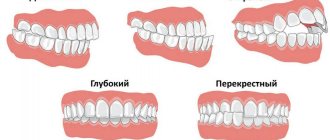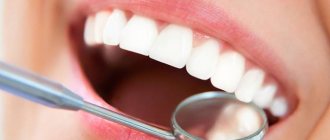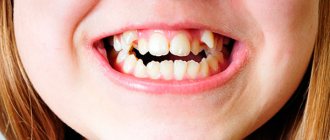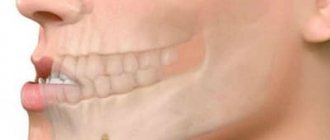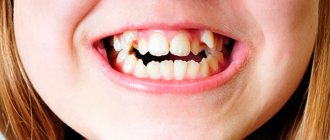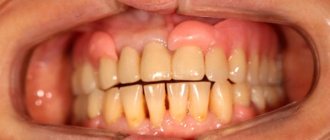Bite pathologies are one of the most common reasons for visiting a dentist. People have been engaged in returning teeth “to their place” since ancient times - there is evidence that this issue was of interest in ancient Egypt. However, only in recent decades have doctors come to the conclusion that it is necessary to correct an abnormal bite. Timely orthodontic treatment helps to avoid serious consequences for the entire body in the future. In this article, the leading orthodontist at the ZUUB dental clinic on Lipetskaya in Moscow, Dmitry Anatolyevich Polovkov, talks about the dangers of malocclusion and ways to correct it.
Correct bite - what is it?
Normal, or physiological occlusion, is characterized by the absence of disturbances in the arrangement of the dentition relative to each other with the jaws fully closed. He can be:
- regular, or orthognathic - in this case, the upper teeth overlap the lower teeth by a third of their height and there are no pronounced gaps between the dentition;
- straight - both jaws clearly close;
- biprognathic - both the upper and lower dentition are slightly tilted forward;
- progenic - only the lower jaw is pushed forward a little, but this does not prevent the cutting edges of the teeth from completely closing.
Correct bite is the absence of pronounced gaps between the teeth when the upper teeth are in contact with the lower ones opposite them. Orthodontists determine a bite without pathologies based on the following characteristics.
- The upper front teeth overlap the lower ones by 1/3 of their height.
- The incisors and canines are arranged in an even, arched line without distortions or crevices.
- The upper teeth protrude slightly outward, the lower teeth “look” slightly inward.
- All teeth are clearly below each other.
- The center of the jaws vertically coincides with the midline of the face, there are no protruding parts of the cheekbones or chin.
It is important to remember that in order to form a correct bite, you need to be careful about teething and caring for them.
Causes of malocclusion
Malocclusion (malocclusion) is due to various reasons: congenital or acquired. An important role is played by genetic factors, as well as insufficient intake of calcium into the mother’s body when carrying a child. Hereditary problems with bite require certain nuances in treatment. Therefore, before carrying out any orthodontic manipulations, the doctor talks with the parents and learns about all the possible factors in the occurrence of pathology.
Acquired malocclusion develops gradually. It appears at different ages due to its own reasons.
In childhood
- Bad habits (finger sucking, pacifiers, chewing on objects).
- Being on artificial feeding.
- Pathological bone formation.
- Teeth grinding (bruxism).
- Lack of sufficient solid food in the child's diet.
- Mouth breathing (formed as a habit or due to respiratory diseases).
- The replacement of baby teeth occurs too sooner or later.
- Pathologies associated with metabolism.
- Calcium and fluoride deficiency.
- Pronounced carious lesion.
- Injuries of the maxillofacial apparatus
In adults
- Installation of unsuitable dentures.
- Diastemas that form as a result of tooth extraction.
- Various types of injuries.
- Lack of space for eights (wisdom teeth).
- Unusual localization of the language.
- Diseases of the musculoskeletal system.
The effect of malocclusion on teeth
Initially, nature built a high margin of safety into all systems of the body, provided that they work in a given rhythm and pace. Incisors with fangs seem to be the strongest, along with bones, and at the same time they are very vulnerable.
A change in the natural position of the jaws provokes damage to the enamel, the appearance of cracks and chips, through which pathogenic bacteria quickly reach the inner layer, penetrating deeper, causing inflammation and tissue destruction. The entire row loses support, subject to gradual deformation. In addition to the aesthetic effect, this arrangement will certainly affect the elasticity and resilience of the ligaments.
Knowing the dangers of malocclusion in adults and what consequences are possible, consult a doctor in time to correct the situation and maintain a beautiful smile.
Types of malocclusion in adults and children
Dentists usually divide anomalous occlusions into planes.
- Sagittal - characterized by elongated/shortened rows of teeth.
- Transversal - narrowed/expanded dentition is visible.
- Vertical - the presence of shortened/elongated certain areas in the dentition.
In addition, in dental practice it is customary to use the following classification of occlusion.
- Distal.
Sagittal occlusion with the upper jaw pushed forward. - Mesial.
Also a sagittal variety, but with the lower jaw moving forward. - Cross.
Transversal pathology with displacement of the jaws, which can only be partially formed, in one direction or another. - Open.
Vertical occlusion occurs with both partial and complete non-occlusion of teeth. - Deep.
The so-called traumatic, contributing to damage to the enamel. Characteristic is almost maximum overlap of the lower rows with the upper ones. - Vertical occlusal anomaly.
In addition to the above listed occlusion disorders, some experts identify 2 more types of anomalies:
- dystopic bite - displacement of one or more teeth;
- reducing - formed due to damaged and (or) lost teeth.
Why do veneers break?
Often, dentists ignore the position of the upper jaw and the spatial location of the occlusion, and this explains the problems that arise during treatment and after it. Chipped teeth, chipped ceramics, cracked and peeling veneers, all periodontal problems and relapses after orthodontic treatment are a small part of the problems that arise if the doctor ignored the analysis of the spatial orientation of the upper jaw and did not establish why certain changes occurred in the skull and dental system. It is from this moment that analysis begins, the meaning of which
determine what is the cause of the asymmetries and deformations of the dentition, distortions of the skull and jaws and spasms of the muscles of the face and neck.
The position and size of the lower jaw are also important, and one of the main questions we need to answer is: “Where does the lower jaw want to be?” Therefore, the second important criterion is the condition of the temporomandibular joint (TMJ). Form determines function. In this case we are talking about the movement (function) of the lower jaw. It is the path of movement of the lower jaw that determines the shape of the dentition and the nature of their closure.
With malocclusion pathologies, the muscles responsible for the movement of the jaw work in a spasmodic, unstable state, so the lower jaw will inevitably deviate from a straight path when opening and closing the mouth. We can measure this deviation and the work of muscles, as well as joints, using special diagnostic computer equipment.
Thus, an important goal of our treatment is to achieve stable muscular-articular movement of the lower jaw without deviations with maximum closure of the teeth.
How to correct a child's malocclusion
- Children under 7 years of age
are shown a set of gymnastic exercises and massage that will help solve the problem. - Children under 10 years of age
are already prescribed trainers, with the help of which they can set the desired direction for their teeth. They must be worn for a certain number of hours during the day. But, if the pathologies are more advanced, removable plates and mouthguards are used. Correction of the anomaly takes approximately 2 years. - For children aged 10-12
years, braces are used to correct their bite - special orthodontic structures consisting of a power arch and clasps that set an individual direction for each tooth. They cannot be placed at an earlier age; it is necessary that all milk teeth be replaced by permanent ones. How long to wear braces for malocclusion is determined by the treating orthodontist.
How to correct malocclusion in an adult
A very common treatment method for adults is wearing braces. Transparent aligners (aligners) are also very popular now. They are made of transparent plastic material. Aligners are effective in correcting impaired occlusion, are easy to use and look very aesthetically pleasing. All details about this technique can be found here.
In cases where the patient is not in the mood for long-term bite correction with aligners or braces, there is another solution - microprosthetics. In this case, special overlays are installed on the teeth - veneers, with the help of which you can correct uneven teeth and gaps between them. But if there are serious malocclusions, this technique is not used.
There are bite defects for which only surgical treatment is indicated. Examples include: severe malocclusion, facial asymmetry due to trauma or hereditary causes, and chin dysplasia.
Each method of orthodontic treatment has both indications and contraindications. Only an orthodontist can determine the method of treatment after a thorough examination and full diagnosis.
Symptoms of facial asymmetry
The severity of facial asymmetry and the reasons that led to the appearance of defects are the two main factors on which the clinical picture of the pathology depends. Minor violations that occur due to age-related changes are considered to be only an aesthetic problem. Gross disproportion of the facial part of the body is usually observed after severe injuries or serious illnesses. Symptoms of changes on the side of the injury are easy to notice externally:
- facial muscles are not involved in movements;
- the corner of the mouth drops;
- articulation is impaired;
- natural folds on the forehead and in the area of the nasolabial triangle are smoothed out;
- the patient cannot completely close one eye;
- while eating, the work of the lacrimal glands increases;
- there is no facial expression on one side of the face.
Consequences of malocclusion
It is a mistake to think that a pathological bite concerns only appearance and only leads to an unattractive smile. This is where the problems arise that are more serious. For example, in 90% of people with abnormal occlusion, incorrect posture is also detected. There is a logical explanation for this: with a broken bite, the center of gravity of the head shifts. This in turn affects the compensation mechanisms of the musculo-ligamentous apparatus of the maxillofacial system. The result of all this is an increase in the pathology of teeth closure.
Aesthetically, occlusion abnormalities lead to facial asymmetry. A weak-willed chin becomes pronounced, and lips protrude unattractively.
What is the danger of malocclusion?
In addition to visual problems, more serious dysfunctions often occur, including internal organs.
- Due to increased and uneven load on the teeth, periodontal disease develops and teeth begin to decay.
- Inadequate chewing of food leads to disruption of the digestive system.
- The functioning of the temporomandibular joint is impaired.
- The respiratory system also begins to malfunction.
- Slow metabolism.
- Increased risk of developing caries, especially with cross-closing teeth.
- Problems with pronunciation of sounds.
In addition, with malocclusions, daily dental care becomes much more difficult, which contributes to the constant accumulation of plaque on them.
Make an appointment
right now!
Polovkov Dmitry Anatolievich
Orthodontist
What is the danger of facial asymmetry due to malocclusion?
- excessive tension in the temporomandibular joint: this problem provokes headaches, joint dislocations, tension in the neck muscles, curvature of the spine, “clicking” of the jaw, the appearance of bruxism - involuntary grinding of teeth during sleep,
- teeth wear unevenly , which not only aggravates facial asymmetry and complicates chewing food, but also leads to dental problems (the formation of caries and its complications, the appearance of plaque and tartar on the teeth, frequent inflammation of the gums),
- psychological problems: decreased self-esteem
What to do to avoid malocclusion.
The consequences of malocclusion can be avoided by taking measures in time, namely in childhood. Here the responsibility falls largely on parents, who can promptly pay attention to problems and carry out prevention. It is important to take into account the risk of congenital disorders, hereditary predisposition, and also eliminate unfavorable factors:
- prevent the development of rickets and other diseases that impair bone growth;
- bottle feed your baby correctly;
- monitor the position of the child’s body during sleep (posture without tension, head not tilted back, etc.);
- maintain correct posture;
- timely wean your child off the pacifier, thumb sucking habit, toys and other objects;
- treat baby teeth immediately, because their early loss (as well as too late) can negatively affect the bite;
- to prevent nasal breathing disorders, namely to treat diseases of the ENT organs and ARVI.
When anomalies in the development of teeth are identified in childhood, timely assistance from an orthodontist will help solve problems faster than in advanced cases in adults. In children, as a rule, there is no need for surgical intervention yet, and even a complex of therapeutic exercises for the facial muscles can significantly help in correcting the bite.
Publisher: Expert magazine about dentistry Startsmile.ru
Stages of treatment and cost of braces
Only based on the analysis of all the above criteria, it is possible to determine the stages of orthodontic treatment (installation of braces or correction of bite with the ALF apparatus), its cost and timing. And also talk about long-term prognoses of orthopedic and aesthetic restoration of teeth with veneers.
Braketomania, which has captured the minds of dentists and patients who have not delved into the essence of the problem, leads to disastrous results, condemning patients to lifelong prescriptions from general practitioners (neurologists, cardiologists, ENT doctors, etc.)
If you are thinking about and planning orthodontic treatment or the installation of veneers, implants and further prosthetics, or you have begun to notice asymmetry of the face and lips, sign up for a consultation and diagnosis with the administrator. 229-78-83


